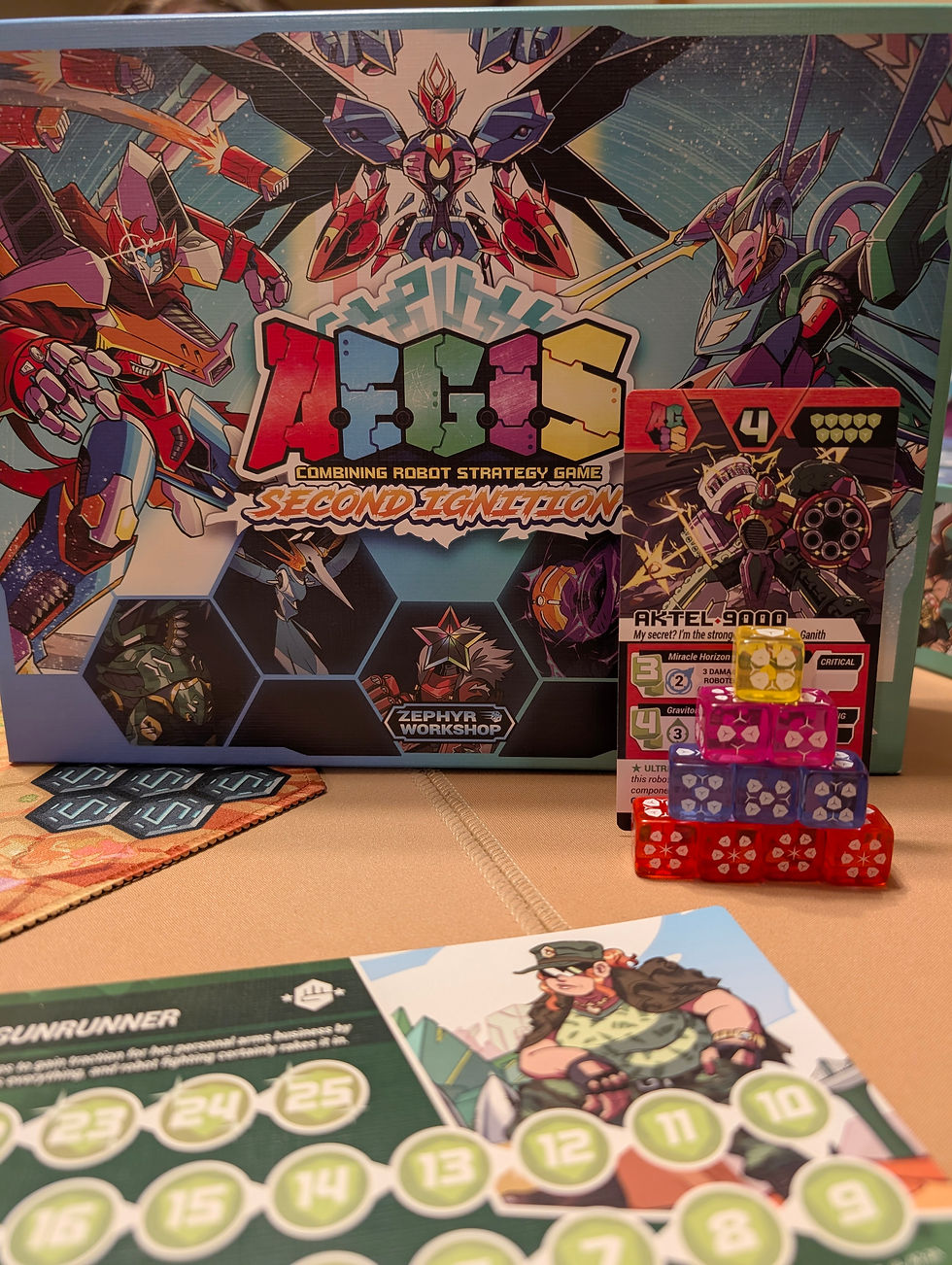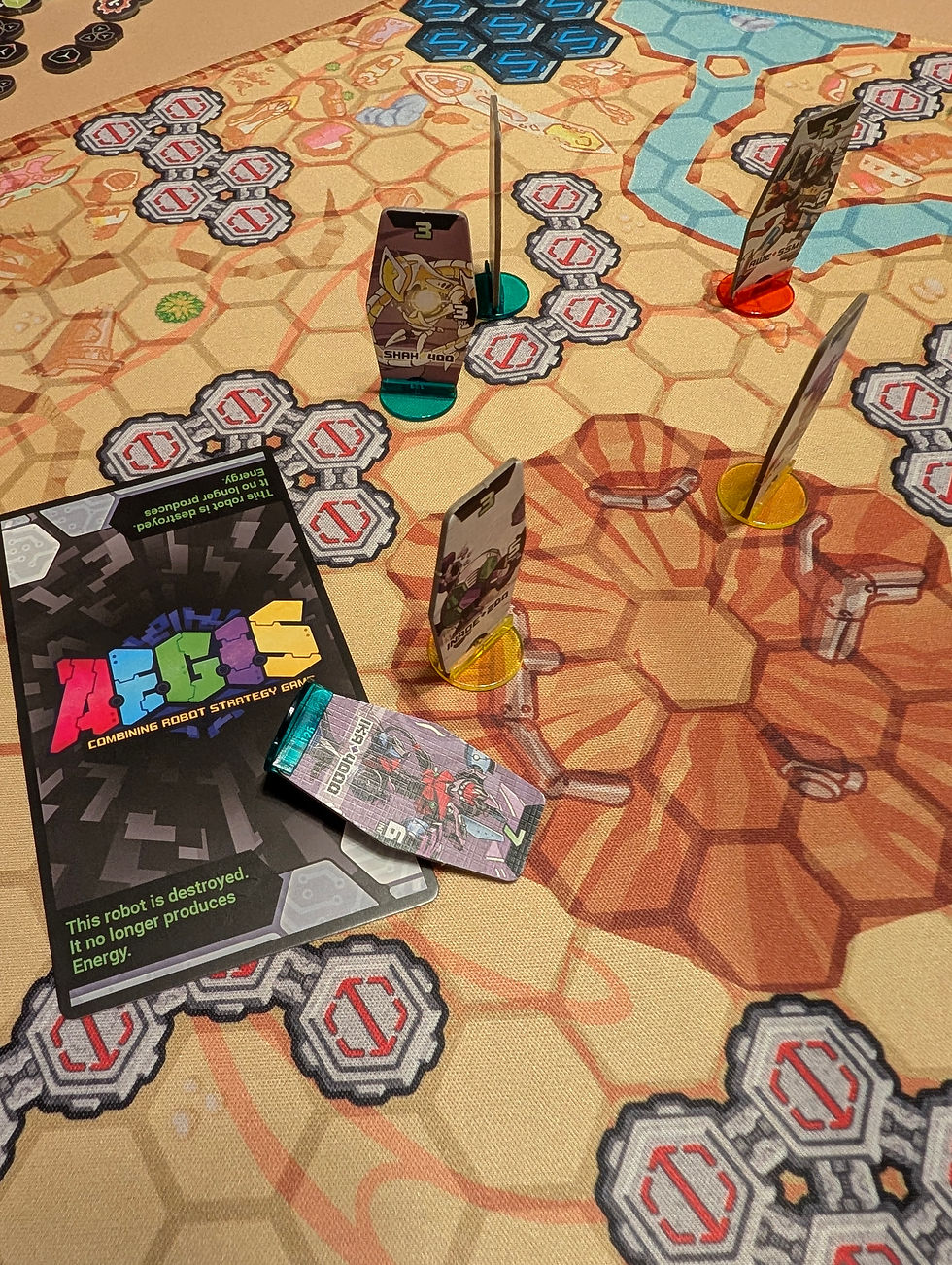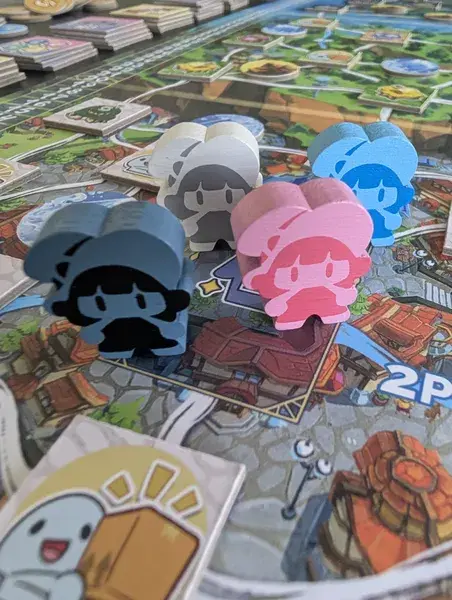A.E.G.I.S.: Second Ignition – First Impressions
- Coty

- Sep 11, 2025
- 4 min read

A.E.G.I.S.: Second Ignition is all about sparks, steel, and smashing robots together until they combine into something bigger, or get destroyed. It’s tactical, chaotic, and blends dice chucking with clever positioning. The game is published by Zephyr Workshop, and it plays 1–4 players. It has an expansion that allows for up to six players
I tried a three player game on the expansion six player mat. The hex board gave me nostalgic Chinese Checkers vibes. If Chinese Checkers had blocked spaces, missiles, lasers, and giant anime mechs shouting “Combine!”
The game is designed by Cassandra Clark, Breeze Grigas, and Zach Kettell. The production is gorgeous: bold art, flashy standees, and tokens that pop. I was ready to love it. Dice rolling, robots combining, big tactical battles? Yes please!
⚠️ Disclaimer: I do not usually play war strategy or miniature games, so my perspective might be very different from someone who does. After playing AEGIS, I realized this one might not be for me. And that’s a shame, because who doesn’t like the excitement of rolling dice?
I’ll give it another go with more of an RPG twist. If you lean into narration and storytelling, I think it could really shine. The art, the boards, the robots, it all looks like an anime crossover dropped onto your table. But for me, the gameplay didn’t click. And that’s rough to admit, because I wanted to love it
What’s the Game About?
At its core, A.E.G.I.S. is a tactical combat game where each player builds a squad of five robots and battles it out. There are five robot classes, and together they spell the game’s name:
Assault: Aggressive attackers with melee and guns
Evasive: Fast scouts with bombs, missiles, and machine guns
Guard: Big tanks that soak up damage
Intel: Tricksters with lightning and energy abilities
Support: Long-range helpers and healers
Each robot generates energy at the start of your turn, which you spend to move, attack, or activate special abilities. Each hex you move costs one energy, and most actions require dice rolls that also consume energy. Managing this resource is key as you balance positioning, attacking, and saving enough for powerful combinations. Robots can also merge into larger forms, fusing multiple units into one more powerful robot
Victory comes when your opponents can no longer function effectively. Either they can’t produce at least five points to keep their team running, or their remaining robots can’t deal damage, drain energy, or move other robots around the battlefield

My Experience
The variety in this game is staggering. There are over 100 unique robots, each with a card and standee. You could play dozens of times and never field the same squad. The rulebook is detailed and well-written, and the system has a lot of clever ideas. And yet… I struggled 😭
Pacing: while the system allows for big tactical setups, the game can drag. In the three-player variant, players start too far apart. You’ll often spend two or three turns just maneuvering into position and playing defensively before the action really starts
Analysis Paralysis: If you thrive on complex decisions, this game has plenty. For me, though, the sheer number of options (which robot to activate, where to move, which action to use, whether to combine) slowed things to a crawl as players calculated every possibility. I’m hopeful this eases with more experience
Combining Robots: Cool in theory, confusing in practice. Once standees start fusing into duos, trios, or beyond, I often wasn’t sure who was who or where my target had moved to
Dice Probability: Some attacks feel frustratingly punishing. When you roll three dice and all of them need to be greater than a certain number, it can waste precious energy and come up empty
Components: The iconography is heavy, and while the summary cards help, there’s a lot to absorb at first. Plus, there just aren’t enough damage tokens to go around
That said, when the system clicks, you really do feel like you’re commanding an over-the-top anime battle, complete with giant robots clashing, combining, and pulling off big cinematic moves
Who Is This Game For?
This is a game for players who:
Love tactical skirmish games and plotting every move like a battlefield general
Grew up on anime mechs and dream of shouting at the table
Enjoy long, swingy battles with crunchy rules
Don’t mind chaos and dice luck in their strategy
Pros:
💕 Gorgeous artwork and components
🤖 Loads of unique robots, tons of variety
🎲 Multiple game modes
📍 Pre-built squads and detailed rules to get you started
Cons:
Gameplay can drag
Combined robots are hard to track on the board
If luck is not in your favor, dice can be punishing
Iconography learning curve is steep
Final Thoughts
I wanted to love A.E.G.I.S.: Second Ignition. The concept, the style, the dice-chucking chaos, it all seemed tailor-made for me. But in practice, I found myself more frustrated than thrilled. That doesn’t mean it’s a bad game. For the right group, especially those who thrive on tactical depth and anime-style battles, this could be an absolute hit. For me, though? I may try it once more with a narrative. In the meantime, I’ll admire it from afar and let someone else pilot the giant robot





Comments